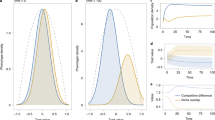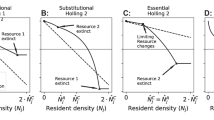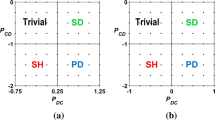Abstract
The meaning of ‘niche’ and ‘competitive ability’ have long been surrounded by controversy. The reason for this stems from the obscure relationship that exists between these terms. This extends from the views of Darwin through Eltonian tradition to current views in which the meaning of competitive ability is implicitly infused into the paradigm of niche. Distinct operational definitions for niche and competitive ability are therefore established with special reference to plants. It is proposed that potential ‘niche’ refer explicitly to a theoretical hyperspace of ‘places’ where a species would leave descendents if all biotic interactions were precluded, and that competitive ability refer to the relative capacity to leave descendents in a particular ‘place’ in the face of restrictions imposed by competitive interaction. This leads to a qualitative comprehensive theory for coexistence which may be extended to any type of biotic interaction. Niche and competitive ability are both determined by the biological attributes of a species and may be independently adjusted in a population by natural selection in contexts of competition. Species coexistence in nature may therefore be a consequence of alternative evolutionary mechanisms which may operate to various degrees in concert: (1) natural selection leading to niche differentiation; (2) an ongoing process of reciprocal selection (coevolution) which maintains an approximate balance in relative competitive abilities for contested resources.
Similar content being viewed by others
References
Aarssen, L.W. (1983). Ecological combining ability and competitive combining ability in plants: Towards a general evolutionary theory of coexistence in systems of competition. - Amer. Natur. 122: 707–731.
Alley, T.R. (1982). Competition theory, evolution, and the concept of an ecological niche. - Acta biotheor. 31: 165–179.
Antonovics, J. (1978). The population genetics of mixtures. In J.R. Wilson (Ed.). Plant relations in pastures, 233–252. - East Melbourne, Australia: CSIRO.
Austin, M.P. (1982). Use of a relative physiological performance value in the prediction of performance in multispecies mixtures from monoculture performance. - J. Ecol. 70: 559–570.
Bann Hofman, T., and Ennik, G.C. (1982). The effect of root mass of perennial ryegrass (Lolium perenne L.) on the competitive ability with respect to couchgrass (Elytrigia repens (L.) Desv.). - Neth. J. Agric. Sci. 30: 275–283.
Barea, J.M. and Azcon-Aguilar, C. (1983). Mycorrhizas and their significance in nodulating nitrogen-fixing plants. - Adv. Agron. 36: 1–54.
Berendse, F. (1981). Competition and equilibrium in grassland communities. Ph.D. Thesis. University of Utrecht, The Netherlands, Grassland Research Group Publications No. 44.
Bergh, J.B. van den (1968). An analysis of yields of grasses in mixed and pure stands. - Versl. Landbouwk. Onderz. 714: 1–71.
Bergh, J.B. van den and Braakhekke, W.G. (1978). Coexistence of plant species by niche differentiation. In A.H.J. Freysen and J.W. Woldendorp (Eds.), Structure and functioning in plant populations, 125–138. - Amsterdam: North-Holland.
Birch, L.C. (1957). The meaning of competition. - Amer. Natur. 41: 5–18.
Black, J.N. (1958). Competition between plants of different initial seed sizes in swards of subterranean clover (Trifolium subteraneum L.) with particular reference to leaf area and the light microclimate. - Aust. J. Agric. Res. 9: 299–318.
Black, J.N. (1960). The significance of petiole length, leaf area, and light interception in competition between strains of subterranean clover (Trifolium subterraneum L.) grown in swards. - Aust. J. Agric. Res. 11: 177–291.
Burden, J.J. and Chilvers, G.A. (1977). The effect of barley mildew on balrey and wheat competition in mixtures. - Aust. J Bot. 25: 59–65.
Case, T.J. and Gilpin, M.E. (1974). Interference competition and niche theory. - Proc. Nat. Acad. Sci. 71: 3073–3077.
Colinvaux, P.A. (1982). Towards a theory of history: Fitness, niche and clutch in Homo sapiens L. - The fourth Tansley lecture. J. Ecol. 70: 393–412.
Connell, J.H. (1975). Some mechanisms producing structure in natural communities: A model and evidence from field experiments. In M.L. Cody and J.M. Diamond (Eds.), Ecology and Evolution of Communities, 460–490. - Cambridge: Harvard University Press.
Crush, J.R. (1974). Plant growth responses to vesicular-arbuscular mycorrhiza. VII. Growth and nodulation of some herbage legumes. - New Phytologist 73: 743–749.
Darwin, C. (1859). On the origin of species. 6th edn. Everyman's Library (1928). Dent, London.
Davidson, D.W., and Morton, S.R. (1981). Competition for dispersal in ant-dispersed plants. - Science 213: 1259–1261.
Diamond, J.M. (1978). Niche shifts and the rediscovery of interspecific competition. - Am. Sci. 66: 322–331.
Donald, C.M. (1963). Competition among crop and pasture plants. - Adv. Agron. 15: 1–118.
Donald, C.M., and Hamblin, J. (1983). The convergent evolution of annual seed crops in agriculture. - Adv. Agron. 36: 97–143.
Elton, C. (1927). Animal ecology. - London: Sedgewick & Jackson.
Gill, D.E. (1974). Intrinsic rate of increase, saturation density and competitive ability. 11. The evolution of competitive ability. - Amer. Natur. 108: 103–116.
Givinish, T. (1979). On the adaptive significance of leaf form. In O.T. Solbrig, S. Jain, G.B. Johnson and P.H. Raven (Eds.), Topics in plant population biology, 375–407. - N.Y.: Columbia University Press.
Greuter, W. (1972). The relict element of the flora of Crete and its evolutionary significance. In D.H. Valentine (Ed.), Taxonomy, phytogeography and evolution, 161–177. - London: Academic Press.
Grime, J.P. (1973). Competitive exclusion in herbaceous vegetation. - Nature 242: 344–347.
Grime, J.P. (1979). Plant strategies and vegetation processes. - New York: Wiley.
Haefner, J.W. (1980). Two metaphors of the niche. - Synthese 43: 123–153.
Grubb, P.J. (1977). The maintenance of species richness in plant communities: The importance of the regeneration niche. - Biol. Rev 52: 107–145.
Hairston, N.G. (1983). Alpha selection in competing salamanders: Experimental verification of an a priori hypothesis. - Am. Nat. 122: 105–113.
Hall, R.L. (1974). Analysis of the nature of interference between plants of different species. I. Concepts and extension of the de Wit analysis to examine effects. - Aust. J. Agric. Res. 25: 739–747.
Harper, J.L. (1961). Approaches to the study of plant competition. In F.L. Milthorpe (Ed.), Mechanisms in biological competition. - Symp. Soc. Exp. Biol. 15: l–39.
Harper, J.L. (1964). The nature and consequence of interference amongst plants. In Genetics today. Proc. XI. - Int. Cong. Genetics 2: 465–482.
Harper, J.L. (1965). Establishment, aggression and cohabitation in weedy species. In H.G. Baker and G.L. Stebbins (Eds.), The genetics of colonizing species, 243–265. - New York: Academic Press.
Harper, J.L. (1968). The regulation of numbers and mass in plant populations. In R.C. Lewontin (Ed.), Population biology and evolution, 139–158. - Syracuse, N.Y.
Harper, J.L. (1977). Population biology of plants. - London: Academic Press.
Harper, J.L. (1978). Response to J.P. Grime: Interpretation of small-scale patterns in the distribution of plant species in space and time, p. 122. In A.H.J. Freysen and J.W. Woldendorp (Eds.), Structure and functioning of plant populations. - Amsterdam: NorthHolland.
Harper, J.L., and Clatworth, J.N. (1963). The comparative biology of closely related species. VI. Analysis of the growth of Trifolium repens and T. fragiferum in pure and mixed populations. - J. Exp. Bot. 14: 172–190.
Hartnett, D.C., and Bazzaz, F.A. (1983). Physiological integration among intraclonal ramets in Solidago canadensis. - Ecology 64: 779–788.
Hobbs, G.A., Nummi, W.O., and Viroster, J.F. (1961). Food-gathering behaviour of honey, bumble, and leaf-cutter bees (Hymenoptera: Apoidea) in Alberta. - The Canadian Entomologist 93: 409–419.
Hurlbert, S.H. (1981). A gentle depilation of the niche: Dicean resource sets in resource hyperspace. - Evol. Theor. 5: 177–184.
Janzen, D.H. (1966). Coevolution of mutualism between ants and acacias in Central America. - Evolution 20: 249–275.
Kanchan, S., and Jayachandra, (1980). Pollen allelopathy: A new phenomenon. - New Phytol. 84: 739–746.
Krebs, C.J. (1979). Ecology: The experimental analysis of distribution and abundance, 2nd ed. - New York: Harper & Row.
Levin, D.A., and Anderson, W.A. (1970). Competition for pollinators between simultaneously flowering species. - Amer. Natur. 104: 455–467.
Levins, R. (1968). Toward an evolutionary theory of the niche. In T.D. Drake (Ed.), Evolution and environment, 325–340. - New Haven, Conn.: Yale University Press.
MacArthur, R. (1968). The theory of the niche. In R.C. Lewontin, (Ed.), Population biology and evolution, 159–176. - Syracuse, N.Y.
MacMahon, J.A., Schimpf, D.J., Anderson, D.C., Smith, K.G., and Bayn, R.L., Jr. (1981). An organism-centered approach to some community and ecosystem concepts. - J. Theor. Biol. 88: 287–307.
Mahmoud, A., and Grime, J.P. (1976). An analysis of competitive ability in three perennial grasses. - New Phytol. 77: 431–435.
Menge, B.A. (1979). Coexistence between the seastars Asterias vulgaris and A. forbesi in a heterogeneous environment: A non-equilibrium explanation. - Oecologia 41: 245–272.
Miller, R.S. (1967). Pattern and process in competition. - Adv. Ecol. Res. 4: 1–81.
Miller, R.S. (1969). Competition and species diversity. In Diversity and stability in ecological systems. - Brookhaven Symp. Biol. 22: 63–70.
Milne, A. (1961). Definition of competition among animals. In F.L. Milthorpe (Ed.), Mechanisms of biological competition, 40–61. - Symp. Soc. Exp. Biol. XV. Cambridge: Cambridge University Press.
Monsi, M., Uchijima, Z., and Oikawa, T. (1973). Structure of foliage and photosynthesis. - Ann. Rev. Ecol. Syst. 4: 301–328.
Newman, E.I. (1982). Niche separation and species diversity in terrestrial vegetation. In E.I. Newman (Ed.), The plant community as a working mechanism, 61–77. - Spec. Publ. No. 1, Brit. Ecol. Soc. Oxford: Blackwell Scientific Publ.
Patten, B.C., and Auble, F.T. (1981). System theory of the ecological niche. - Amer. Natur. 117: 893–922.
Pianka, E.R. (1983). Evolutionary ecology, 3rd edn. - New York: Harper & Row.
Pickett, S.T.A. (1980). Non-equilibrium coexistence of plants. - Bull. Torr. Bot. Club 107: 238–248.
Pontin, A.J. (1982). Competition and coexistence of species. - London: Pitman Advanced Publishing Program.
Rejmanek, M., and Jenik, J. (1975). Niche, habitat, and related ecological concepts. - Acta biother. 24: 100–107.
Rice, B., and Westoby, M. (1982). Heteroecious rusts as agents of interference competition. - Evol. Theory 6: 43–52.
Rice, E.L. (1974). Allelopathy. - New York: Academic Press.
Rice, E.L. (1979). Allelopathy - An update. - Bot. Rev. 45: 15–109.
Ricklefs, R.E. (1979). Ecology, 2nd edn. - New York: Chiron Press.
Risser, P.G. (1969). Competitive relationships among herbaceous grassland plants. - Bot. Rev. 35: 251–284.
Roughgarden, J. (1979). Theory of population genetics and evolutionary ecology: An introduction. - New York: MacMillan.
Salisbury, E.J. (1929). The biological equipment of species in relation to competition. - J. Ecol. 17: 197–222.
Sandfaer, J. (1968). Induced sterility as a factor in the competition between barley varieties. - Nature 218: 241–243.
Sandfaer, J. (1970). Barley stripe mosaic virus as the cause of the sterility interaction between barley varieties. - Hereditas 64: 150–152.
Schoener, T.W. (1974). Resource partitioning in ecological communities. - Science 185: 27–29.
Schoener, T.W. (1982). The controversy over interspecific competition. - Amer. Sci. 70: 586–595.
Tilman, D. (1977). Resource competition between planktonic algae: An experimental and theoretical approach. - Ecology 58: 338–348.
Tinnin, R.O. (1972). Interference or competition. - Amer. Natur. 106: 672–675.
Vandermeer, J.H. (1972). Niche theory. - Ann. Rev. Ecol. Syst. 3: 107–132.
Wangersky, P.J. (1972). Evolution and the niche concept. In E.S. Deevey (Ed.), Growth by Intussusception. Transactions Connecticut Academy Arts and Sciences 44: 367–376.
Werner, P.A. (1975). The effects of plant litter on germination in teasel, Dipsacus, sylvestris Huds. - Amer. Midi. Natur. 94: 470–476.
Whittaker, R.H. (1967). Gradient analysis of vegetation. - Biol. Rev. 49: 207–264.
Whittaker, R. H., Levin, S.A., and Root, R. B. (1973). Niche, habitat and ecotope. - Amer. Natur. 107: 321–338.
Whittingham, J., and Read, D.J. (1982). Vesicular-arbuscular mycorrhiza in natural vegetation systems. III. Nutrient transfer between plants with mycorrhizal interconnection. - New Phytol. 90: 277–284.
Willson, M.F. (1973). Evolutionary ecology of plants. A review. Part IV. Niches and competition. - The Biologist 55: 74–82.
Windle, P.N., and Franz, E.H. (1979). The effects of insect parasitism on plant competition: Greenbugs and barley. - Ecology 60: 521–529.
de Wit, C.T. (1960). On competition. - Versl. Landbouwk. Onderz. 66: 1–82.
de Wit, C.T (1970). On the modelling of competitive phenomena. - Proc. Adv. Study Inst. Dynamics Numbers Popul., 269–281. (Oosterbeek, 1970).
Author information
Authors and Affiliations
Rights and permissions
About this article
Cite this article
Aarssen, L.W. On the distinction between niche and competitive ability: Implications for coexistence theory. Acta Biotheor 33, 67–83 (1984). https://doi.org/10.1007/BF00052146
Received:
Issue Date:
DOI: https://doi.org/10.1007/BF00052146




